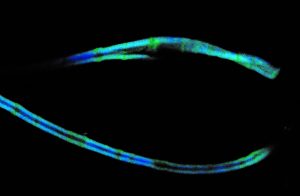Our research focuses on the role of seafloor processes in ocean chemical cycles and ecology, the biogeochemical influences of hypoxia and anoxia, and new electrochemical tools and sensors for ocean observing networks. Recent projects have targeted the Oregon continental margin using aquatic eddy covariance as a non-invasive method to assess benthic oxygen fluxes.
Aquatic Eddy Covariance
Benthic oxygen fluxes represent the rate that oxygen dissolved in seawater is consumed (or produced) by the biological community at the seafloor. Essential to eddy covariance measurements are reliable, fast responding, low noise, and fully calibrated oxygen sensors. In 2018 and 2019, we made repeated EC measurements at sites at 30 m and 80 m water depth adjacent to the Oregon line of the Ocean Observatories Initiative (OOI) Endurance Array to assess if there are changes in the biological activity of sediments due to seasonal changes in organic matter input from overlying waters. High fluxes observed in winter months suggest that enough labile marine organic matter is retained in the shelf environment throughout the year to support substantial benthic fluxes of oxygen, total carbon dioxide and nutrients that are important in setting bottom water conditions at the start of the summer upwelling season.

Benthic Microbial Fuel Cells and Cable Bacteria

Our group also continues to develop and evaluate revolutionary benthic microbial fuel cells (BMFCs) – devices designed as self-refueling power sources for fixed seafloor sensors. We have demonstrated powering acoustic modem/chemical sensor systems by unattended BMFCs at water depths ranging from 10-1000 m. We are investigating the microbial communities and chemistries that enable electron transfer in these systems. A unique discovery we made was finding multicellular, filamentous, sulfur-oxidizing bacteria, known as cable bacteria, attached to fibers of a carbon brush electrode serving as an anode of a benthic microbial fuel cell. This finding indicates that cable bacteria may in fact be facultative anaerobes. We are conducting follow-on work to use bioelectrochemical systems and autoclaved sediments to enrich for cable bacteria and to study their mechanisms of electron transport from cell to cell and to a solid electrode. To learn more about our research please go to the links above.